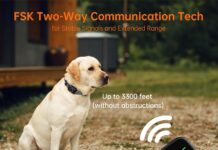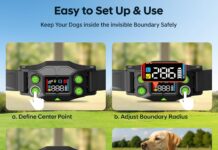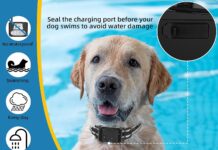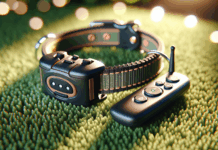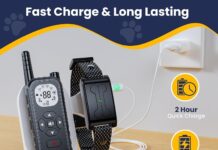When choosing the perfect dog collar, finding the right size is vital. We all want our furry friends to be comfortable and safe, so it’s essential to take the time to pick the right fit.
From measuring your dog’s neck to considering their breed and age, there are a few factors to consider while making this decision.
In this article, we will guide you through the process of selecting the ideal collar size for your beloved canine companion, ensuring their style and comfort go hand in paw.
Factors to Consider
Breed and Size of the Dog
When choosing a dog collar, it is essential to consider the breed and size of your furry friend. Different breeds have different neck sizes and proportions, so selecting a collar that correctly fits your dog is crucial. Larger breeds require broader and sturdier collars, while smaller breeds may need narrower and lighter options to ensure comfort and safety.
Age and Growth Rate
Dogs, especially puppies, grow at different rates. It is essential to consider your dog’s age and growth rate when choosing a collar. Puppies will outgrow their collars quickly, so opting for an adjustable collar or regularly upgrading their collar size will be necessary. Older dogs, on the other hand, may have stable neck sizes and won’t require frequent adjustments.
Collar Usage
Consider your dog’s lifestyle and how they will be using the collar. A basic flat buckle collar may suffice if your dog is mainly indoors and only wears a collar for identification purposes. However, if your dog is active, frequently goes for walks, or engages in outdoor activities, a more durable and secure collar, such as a harness or a martingale collar, might be a better choice.
Comfort and Fit
A well-fitting collar is essential for your dog’s comfort. It should be snug enough to prevent slipping off but not too tight to cause discomfort or restrict breathing. Look for collars with adjustable straps or multiple sizing options to ensure the perfect fit for your dog. Avoid too loose collars, as they may quickly get caught on objects or allow your dog to slip out of them.
Safety Features
Ensuring your dog’s safety when choosing a collar should be a top priority. Look for collars with safety features, such as reflective strips or LED lights, especially if you walk your dog at night. Breakaway collars are also a great option, as they are designed to release if your dog gets tangled or caught on something, preventing choking or injury.
Measuring Your Dog’s Neck
Using a Tape Measure
To measure your dog’s neck, use a flexible tape measure. Wrap the tape measure around the base of your dog’s neck, where the collar would sit. Make sure the tape measure is snug but not too tight. Take note of the measurement in inches or centimeters, as this will be the size you will use when selecting a collar.
Using a String or Ribbon
If you don’t have a tape measure, you can use a string or ribbon to measure your dog’s neck circumference. Wrap the string or ribbon around the base of your dog’s neck, mark where it overlaps, and then measure the marked length with a ruler. This will give you an accurate measurement to select the correct collar size.
Add or Subtract Length
Keep in mind that you may need to add or subtract a few inches from your dog’s neck measurement, depending on the type of collar you choose. For instance, if you’re selecting a buckle collar, adding two inches to the measurement will ensure a comfortable fit. On the other hand, if you’re opting for a martingale collar, subtracting an inch or two will prevent the collar from slipping off.
Choosing the Right Collar Size
Size Recommendations by Breed
Many dog collar manufacturers provide size recommendations based on different breeds. These recommendations can serve as a helpful starting point when selecting a collar for your dog. However, it is essential to remember that not all dogs of the same breed will have the same neck size. So, always measure your dog’s neck accurately to confirm the appropriate size.
Adjustable Collars
Adjustable collars are versatile options that accommodate different sizes and growth stages. These collars typically have multiple holes or a sliding mechanism that allows you to adjust the size according to your dog’s needs. They are particularly beneficial for puppies or dogs that experience weight fluctuations.
Measuring for Martingale Collars
Martingale collars are specifically designed for dogs with narrow heads, such as Greyhounds or Whippets. To measure for a martingale collar, follow the same steps as measuring with a tape measure or string. However, when selecting the collar size, ensure that it fits comfortably around the broadest part of your dog’s head, as this type of collar tightens when pulled.
Sizing for Choke Collars
Choke collars, also known as slip collars, should be used with caution and only under the guidance of a professional trainer. When measuring for a choke collar, you’ll want to ensure that the collar sits high on your dog’s neck, just behind the ears. Remember to add a few inches to the measurement to ensure a proper fit and prevent discomfort or injury.
Different Types of Dog Collars
Flat Buckle Collars
Flat buckle collars are the most common type of dog collar. They consist of a sturdy band with a buckle closure. These collars are suitable for everyday wear and ideal for dogs that do not pull excessively on their leash. They come in various materials, such as nylon, leather, or fabric, providing you with a wide range of options to choose from.
Breakaway Collars
Breakaway collars have a safety feature that releases the collar if it gets caught or entangled. These collars are ideal for cats and cats that frequently roam outdoors. They provide peace of mind, ensuring that your pet can safely free themselves if they become stuck on a branch or any other hazard.
Harnesses
Harnesses are an excellent alternative to traditional collars, especially for dogs that tend to pull or have respiratory issues. They distribute the pressure more evenly across the dog’s body, minimizing strain on the neck and throat. Harnesses come in various styles, including back-clip, front-clip, and dual-clip, offering different leash attachment options.
Prong Collars
Prong collars, also known as pinch collars, are controversial and should only be used under the guidance of a professional dog trainer. These collars have metal prongs that create pressure points when the dog pulls. Prong collars should never be left on unsupervised dogs and should only be used as a last resort for training.
Head Collars
Head collars, such as the popular Gentle Leader or Halti, have straps that loop around your dog’s muzzle, giving you control over their head movements. These collars are beneficial for dogs that are prone to pulling or have aggressive tendencies. It is essential to introduce head collars gradually and properly fit them to ensure your dog’s comfort and safety.
Important Tips
Leave Room for Growth
Puppies increase, so when selecting a collar for a young dog, leave room for growth. Adjustable collars or collars with extra sizing options are excellent choices and will save you from needing to replace the collar frequently. However, ensure the collar is not so loose that your puppy can slip out.
Check for Snug Fit
A collar should fit snugly around your dog’s neck but shouldn’t be too tight. You should be able to comfortably fit two fingers between the collar and your dog’s neck. This ensures that the collar is secure enough to prevent slipping off, but loose enough to avoid causing discomfort or choking hazards.
Observe Signs of Discomfort
Please pay close attention to your dog’s behavior when wearing a collar. Signs of discomfort can include scratching or rubbing their neck excessively, trying to remove or chew on the collar, or displaying signs of agitation or distress. If you notice any of these signs, it may indicate that the collar is too tight, too loose, or causing irritation.
Measure Regularly
It’s essential to measure your dog’s neck periodically, especially during stages of growth. Puppies may need their collar size adjusted more frequently, while older dogs may have stable neck sizes. Regular measuring ensures your dog always has a collar that fits properly and comfortably.
Consult a Professional
If you’re unsure about which collar is best for your dog or how to correctly measure and fit a collar, consult a professional, such as a veterinarian or a professional dog trainer. They can provide guidance and recommendations based on your dog’s specific needs and characteristics.
Additional Considerations
Neck Length
In addition to measuring your dog’s neck circumference, consider their length. Some dogs may have shorter or longer necks, affecting how a collar fits and looks on them. If your dog has a shorter neck, you may need to choose a collar with a narrower width to ensure a comfortable fit.
Fur Thickness
Consider the thickness of your dog’s fur when selecting a collar. Dogs with thicker fur may benefit from collars with shorter fur-safe materials, such as flat nylon or fabric. These materials are less likely to cause matting or discomfort to your dog’s coat.
Style and Design
While functionality and fit are crucial, don’t forget to consider style and design. Collars come in various colors, patterns, and materials, allowing you to choose one that matches your dog’s personality and taste. Keep in mind that reflective or brightly colored collars can also enhance your dog’s visibility, especially during nighttime walks.
Durability and Materials
Different collar materials offer varying degrees of durability. Nylon is famous for its strength and affordability, while leather provides a more classic and durable option. Reflective materials and those resistant to water and odor are also worth considering, depending on your dog’s activities and environment.
Budget
Set a budget before shopping for a dog collar to avoid overspending. Collars can range in price depending on their materials, features, and brand reputation. Remember that quality and functionality should be the top priorities, so be sure to invest in a collar that meets your dog’s needs without compromising safety and comfort.
Popular Dog Collar Brands
1. Coastal Pet Products
Coastal Pet Products offers various collars known for their durability and variety. They provide adjustable, breakaway, and specialized collars for various purposes. Their products focus on safety and comfort, ensuring your dog’s needs are met.
2. Blueberry Pet
Blueberry Pet collars are famous for their stylish designs and quality craftsmanship. They offer various collars in different patterns, colors, and materials. With a focus on fashion and functionality, Blueberry Pet collars provide a comfortable and stylish option for your furry friend.
3. LupinePet
LupinePet is known for its sturdy and customizable collars. Their collars come with a lifetime guarantee, showcasing their commitment to durability and customer satisfaction. With a wide variety of sizes, colors, and designs, LupinePet collars cater to dogs of all breeds and sizes.
4. GoTags
GoTags specializes in personalized collars, allowing you to add your dog’s name and contact information directly on the collar. In addition to customizations, they offer a range of collar styles, including nylon and leather options. GoTags collars prioritize safety and functionality while providing a personalized touch.
5. Red Dingo
Red Dingo is known for its high-quality, durable collars that are both functional and stylish. Their collars feature vibrant colors and unique designs, ensuring that your dog stands out. Red Dingo collars are crafted with top-notch materials and attention to detail, offering a combination of fashion and durability.
Common Mistakes to Avoid
Choosing the Wrong Material
Selecting the wrong material for your dog’s collar can lead to discomfort, irritation, or even allergic reactions. Consider your dog’s specific needs and preferences when choosing a collar material. If your dog has sensitive skin, opt for hypoallergenic materials or fabrics that won’t irritate.
Ignoring Safety Features
Ignoring safety features can put your dog at risk. Reflective strips, LED lights, or breakaway features are designed to keep your dog safe during walks or outdoor activities. Ensure that the collar you choose has the necessary safety features to enhance your dog’s visibility and prevent potential accidents.
Improper Size Adjustment
Improperly adjusting the collar size can result in discomfort or even injury to your dog. Avoid the temptation to leave the collar too loose or too tight. Regularly check the collar’s fit and make necessary adjustments to ensure a snug and comfortable fit. Always follow the manufacturer’s guidelines for proper sizing and adjustment.
Forgetting About Breed Differences
While breed recommendations can be a helpful starting point, it’s important to remember that not all dogs of the same breed have identical neck sizes. Each dog is unique, and accurately measuring your dog’s neck is crucial to finding the correct collar size. When selecting a collar, Don’t rely solely on generalizations about your dog’s breed.
Not Considering Special Needs
Some dogs may have special needs that require specific types of collars. For example, dogs with respiratory issues may benefit from a harness instead of a traditional collar. Dogs that tend to pull excessively may require a head collar for better control. Consider your dog’s unique needs or conditions when choosing a collar.
Summary
Choosing the right dog collar size is essential for the comfort, safety, and well-being of your furry friend. Factors such as breed and size, age and growth rate, collar usage, comfort and fit, and safety features all play a crucial role in selecting the perfect collar.
Measuring your dog’s neck accurately using a tape measure or string and considering the different types of collars available will help you make an informed decision. Remember to leave room for growth, ensure a snug fit, and observe signs of discomfort. Consulting a professional, considering additional factors, and avoiding common mistakes will further assist you in finding the ideal collar for your beloved pet.
With numerous brands offering a variety of styles and designs, you can find a collar that not only meets your dog’s needs but also reflects their unique personality. So, take the time to research, measure, and choose a collar that will keep your dog safe, comfortable, and happy.



